In July 2022, the US announced imposition of punitive import tariffs on Russian products. The EU may also enact sanctions that mirror these in scale and scope. This column estimates that these mirror sanctions would inflict welfare losses on Russia of at least $995 million per year – costing $150 million to EU consumers. However, engaging in mirror sanctions would produce mixed results for the EU. Mirror sanctions could bring inefficiencies for the EU. For example, for some target sectors, higher tariffs would inflict no harm on the Russian economy because of the EU’s lack of importer power vis-à-vis Russian exporters.
At the last G7 Summit in Germany, the US announced plans to significantly increase tariff rates on hundreds of Russian products in response to Russia’s invasion of Ukraine (White House 2022). Presidential Proclamation 10420 raised applicable tariffs on 570 product groups (Note 1) imported from Russia to 35% ad valorem (Federal Register 2022). Given the stated intention of G7 leaders to “align” actions on extra tariff measures on imports from Russia in an “unprecedented” fashion (G7 Research Group 2022a, 2022b), it appears likely that other countries will follow the US lead and soon impose steep tariff increases on Russian import products.
In a recent paper (Latipov et al. 2022a), we engage in a thought experiment of sorts. We examine what would happen if the EU, as one of the staunchest allies of the US on Russia sanctions, were to align itself by imposing ‘mirror’ sanctions, i.e. apply the same 35% ad valorem tariff on the same 570 product groups. Using a sector-by-sector partial-equilibrium framework, we quantify the economic effects that such mirror sanctions would have on the Russian and EU economiesand evaluate (un-)intended consequences of including certain sectors in the EU mirror sanctions package (Note 2). The model is based on a standard Armington-type framework of international trade and is implemented using 2021 trade data as well as elasticity estimates compiled by Soderbery (2018).Soderbery (2018) does not provide for elasticity estimates for the EU as a bloc. We thus apply estimates for Germany (as the largest EU economy and the Russia’s largest European trading partner). This, however, implies that economic effects on Russia reported in this paper are likely underestimated, while welfare losses (gains) to the EU are likely overestimated: the EU as an economic bloc is more powerful than Germany is on its own. Moreover, depending on the specific tariff lines, certain EU members may have more importer power than does Germany. Consequently, EU members collectively constitute a larger and mor powerful export region (from Russia’s perspective), resulting in steeper Russian export supply elasticities vis-à-vis all EU members, and flatter EU import demand elasticities vis-à-vis Russia (Note 3)
Sanctions and restrictions imposed on Russia, as well as their effects on Europe, have been discussed extensively here on VoxEU (e.g. Bachmann et al. 2022, de Jong et al. 2022, Chepeliev et al. 2022, Langot et al. 2022, Mendicino 2022). While various contributions have applied partial-equilibrium frameworks to evaluate (actual or potential) import tariff sanctions on Russia (Gros 2022a, Gros 2022b, Larch et al. 2022, Sturm and Menzel 2022, Sturm 2022a, Sturm 2022b), few, if any, papers disaggregate specific sanction packages sector-by-sector and quantify their economic effects on a sectoral level (the exception being Latipov et al. 2022b, which assesses the economic effects of US import sanctions).
Results
Our model distinguishes 393 individual sectors at the HS 6-digit level that cover the new US tariff sanctions (and thus the EU mirror sanctions) (Note 4).

Table 1 summarises the aggregate economic effects that would result from application of the described tariff increases on hundreds of product groups. In total, EU mirror tariffs would affect trade worth $10.8 billion per year, which represents roughly 6.1% of all 2021 EU imports from Russia (or 20.4% of all non-energy imports). We estimate that these tariffs would cause annual terms-of-trade losses (Note 5) of $597 million and welfare losses to Russia (Note 6) of $996 million; at the same time, they would cost EU consumers $150 million (Note 7).
These results notwithstanding, would adopting the US sanction package and imposing mirror sanctions also be in the EU’s best interest? This question cannot be answered by looking at aggregate effects of the kind presented in Table 1, since totals can mask important dynamics that occur at the sectoral level. We therefore present several observations from our product-level analysis that can shed light on whether, and to what degree, the EU might wish to sign on to the selected sanctions package of the US.
Observation 1: Top ten target sectors generate more than half of total economic effects
A handful of the 570 targeted product groups generate the bulk of economic effects. Table 2 lists the top ten product groups in terms of ‘trade affected’ by EU mirror sanctions. These ten sectors collectively would cover 62%, or $6.7 billion, of all affected EU imports, cause 67% of total Russian welfare losses, and generate self-harm to the EU of $147 million, or 98% of total damages (Note 8).
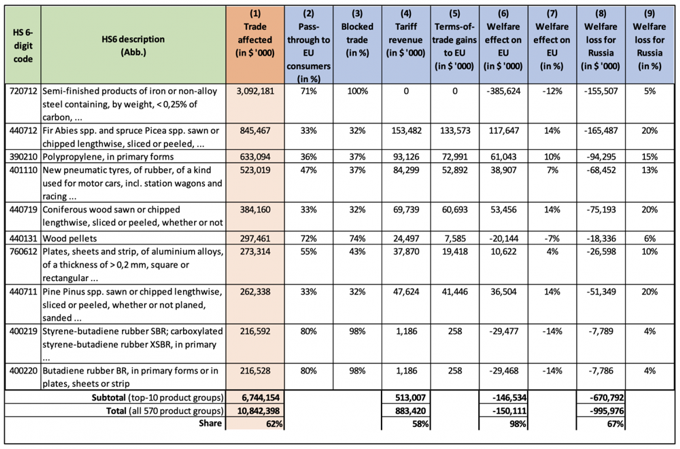
[Click to enlarge]
Note: The list contains top-ten product groups in terms of trade affected (column (1)).
Observation 2: Certain target sectors inflict particularly high welfare losses on Russia
The EU mirror sanction package contains various product groups, the inclusion of which causes particularly large welfare losses to Russia. Table 3 lists all those product groups for which EU mirror sanctions would inflict Russian welfare losses in excess of $10 million (Note 9). These sectors together cause losses of $768 million to the Russian economy. At the same time, mirror tariffs on these products cost the EU economy $46 million. This results in a ‘cost share’ – the ratio of self-harm to harm on Russia – of 6%, an outcome highly favourable to the EU (Note 10).
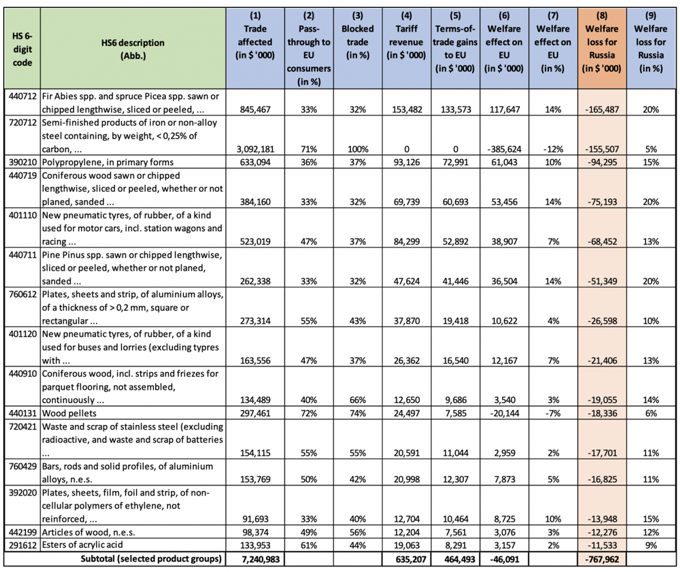
[Click to enlarge]
Note: The list contains product groups for which EU mirror tariff increases result in Russian welfare losses in excess of $10 million (column (8)).
Observation 3: Certain target sectors generate positive welfare effects for the EU
The EU mirror sanction package includes numerous sectors for which tariff increases result in substantial welfare gains to the EU economy. Table 4 lists the top ten product groups for which EU mirror sanctions result in economic gains. Tariff increases on these product lines generate welfare gains to the EU economy of $353 million, as well as Russian welfare losses of roughly $542 million.
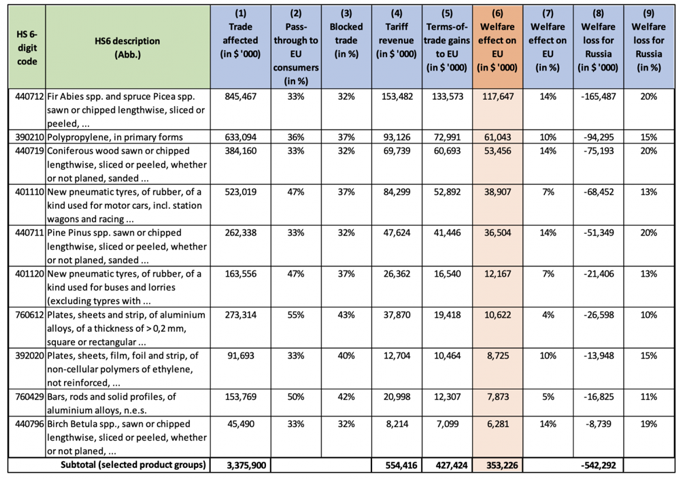
[Click to enlarge]
Note: The list contains top-ten product groups in terms of welfare gains to the EU (column (6)).
Observation 4: Targeting economically insignificant sectors produce negligible results
As mentioned above, the hypothetical EU mirror sanctions contains hundreds of product groups for which importation from Russia may be less significant to the EU economy (Note 11). While there certainly may be valid reasons for including sectors for which Russia is a minor import source (Note 12). there is one subgroup for which inclusion is not immediately obvious. This is the group of those sectors for which Russia is an insignificant import source for the EU economy and the EU is insignificant export destination for the Russian economy (Note 13). Sixty-two sectors fall into this category. EU mirror tariffs on these 62 sectors inflict only $6.6 million economic damage to Russia. It would appear that the administrative effort of implementing and enforcing tariffs on these products may easily outweigh the overall welfare gain of $1.6 million generated.
Observation 5: Mirror sanctions on dozens of sectors would inflict more harm on the EU itself than on Russia
As previously alluded to, EU mirror sanctions on multiple product groups would generate EU welfare losses that exceed those inflicted on Russia. Table 5 lists 20 large sectors for which mirror sanctions inflict more self-harm to the EU than they inflict harm to Russia (Note 14). Tariff increases in these sectors would inflict a total of $216 million to the Russian economy yet cause welfare losses to the EU worth $550 million, resulting in an overall negative difference of $334 million, and a highly unfavourable EU cost share of 254%.
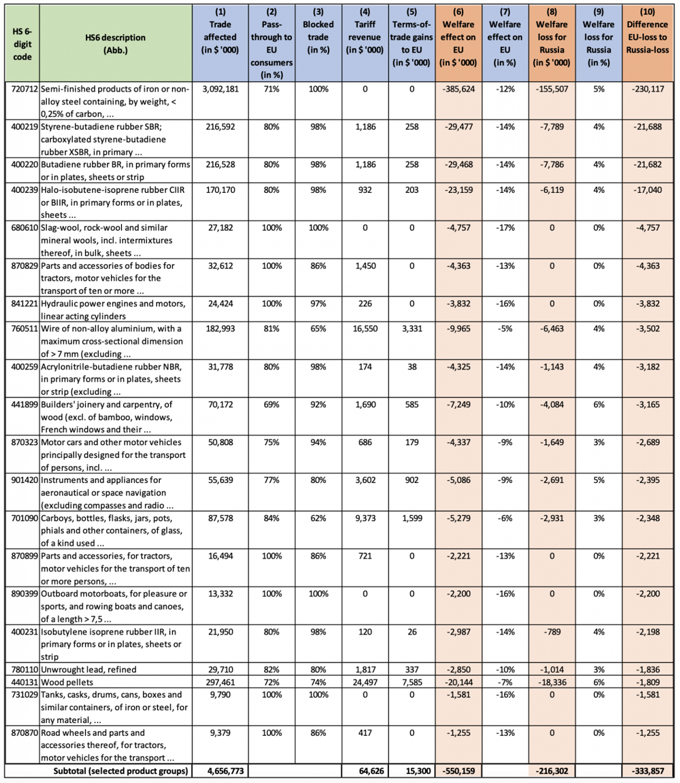
[Click to enlarge]
Note: List contains product groups for which EU mirror sanctions result in excess welfare losses above $2 million (column (10)).
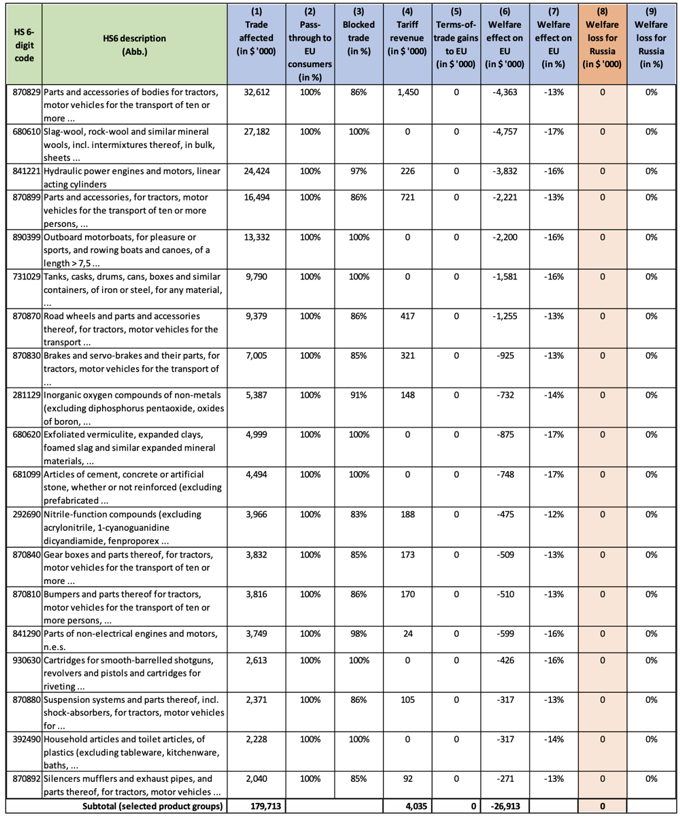
[Click to enlarge]
Note: The list contains product groups where EU trade affected exceeds $1 million (column (1), and for which mirror sanctions result in zero Russian welfare losses (column (8)).
Observation 6: Target sectors with zero or negligible harm to Russia
As a special case of the previous observation, we find a considerable number of targeted product groups for which EU tariff sanctions of any kind would cause zero economic harm to Russia. Table 6 lists large target sectors for which Russia experiences no welfare losses whatsoever due to EU mirror sanctions. In the overwhelming majority of cases, the EU simply has no importer power vis-à-vis Russian exporters. Russian exporters can thus pass on 100% of EU tariff increases to EU consumers, which causes economic pain uniquely in the EU, but none in Russia (Note 15).
Concluding remarks
The US recently announced the imposition of significantly higher import tariffs on 570 product groups from Russia. In our analysis, we assume that the EU fully aligns its actions with the US and imposes ‘mirror’ sanctions of identical scale and scope.
We estimate the overall effects of these EU mirror sanctions and find that they could reduce annual welfare in Russia by $996 million per year, at the cost of $150 million per year to the EU economy.
Our sectoral analysis shows that copying the US sanctions would produce mixed economic results from the EU’s perspective. On the one hand, we identified features of an EU mirror sanctions package that are conducive to maximising harm on the Russian economy while at the same time minimising self-harm to the EU:
- EU mirror sanctions would cover dozens of product groups whose inclusion generates particularly large welfare losses for Russia. These target sectors together inflict economic harm upwards of $760 million to the Russian economy.
- EU mirror sanctions would include numerous sectors for which tariff increases generate particularly high welfare gainsto the EU economy. We estimate that inclusion of the top-10 sectors alone would achieve EU welfare gains of more than $360 million.
We have also identified features of an EU mirror sanctions package that raise questions about its effectiveness for certain sectors:
- For over 70 product groups, mirror sanctions result in EU welfare losses that exceed those suffered by Russia. Overall, the EU’s tariff increases would entail self-harm 2.5 times the size of harm inflicted on Russia.
- For two dozen target large sectors, EU tariffs would even cause zero economic harm to Russia, because the EU lacks any market power vis-à-vis Russian exporters.
- Over 60 sectors targeted by EU mirror sanctions concern sectors for which (i) Russia is an insignificant import source for the EU and (ii) the EU constitutes an insignificant export destination for Russia. EU tariffs on these sectors inflict only minute economic damage on Russia, while EU welfare gains may not outweigh the administrative costs of implementing and policing tariff increases in those sectors.
Considering the mixed results reported of mirror sanctions, the EU may wish to conduct in its own thorough evaluation before simply signing on to the tariff sanction package implemented by the US. One option is for the EU is to carefully select a subset of sectors from the US sanction package. Alternatively, the EU could design its own suite of tariff sanctions – a package that is finetuned to its economic relations with Russia. With the help of an evaluation tool similar to the one presented in Latipov et al. (2022b), the EU could avoid some of the weaknesses exposed above.
This article first appeared on VoxEU on September 30, 2022. Reproduced with permission.





